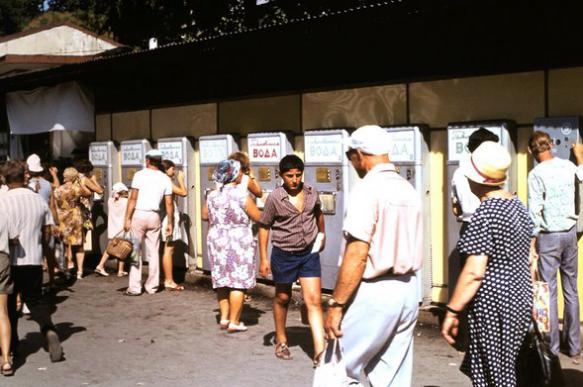History of carbonated water in Russia: National drink and geopolitical weapon
The history of the consumption of carbonated water in Russia counts more than 100 years. Soda water used to be a drink for aristocrats, a national drink and even a weapon of geopolitics - a response to Coca-Cola. Where did soda pop come to Russia from?

Like many great inventions, carbonated water was invented by mistake. Legend has it that "soda" was invented by the cupbearer of King Louis I. When the monarch asked for a glass of wine one day, the cupbearer mixed up wine and juice kegs. He then noticed a mistake and added mineral water into juice. The king liked the drink. This is how the "royal lemonade" was born.
This is a legend, though. In fact, lemonade was known in France in the 17th century as a mixture of lemon juice and mineral water. Only rich people could afford the drink.
Italians used to add various herbs to lemon juice and mineral water. In a nutshell, the world history of lemonade began with mixing lemon juice with mineral water.
It was only in 1767, when English scientist Joseph Priestley invented a saturator, with which it became possible to saturate plain water with carbon dioxide bubbles. First carbonated lemonades appeared already in the beginning of the XIX century, and first lemonade was patented in the USA in 1871.
Lemonade and Peter the Great
The appearance of lemonade in Russia is associated with Peter the Great. The recipe, and most importantly, the fashion for drinking lemonade, came to Russia from Europe. The new drink was a blast in Russia, and the emperor ordered to "drink lemonades at assemblies." Noble and merchant families started making their lemonades too, although the drink was not cheap and could be stored for only one week.
Lemonade in art
By the beginning of the XIX century, lemonade had conquered all of Russia and all layers of the Russian society, although the drink was like lemon water, rather than carbonated lemonade. Mixing it with mineral water was still expensive. Lemonade was mentioned in Pushkin's "The Queen of Spades", in Lermontov's "Masquerade." In one of the Chekhov's stories, a character was drinking lemonade with cognac ("Minds in Ferment").
Soda
In Russia, the history of lemonade received its own unique development. In 1887, pharmaceutics Mitrofan Lagidze came up with an idea to mix aerated water not with lemon juice, but with an extract of Caucasus tarragon, better known as tarkhun. The effervescent and fragrant drink received a number of gold medals at international shows. Subsequently, Mitrofan Lagidze became a supplier to the Imperial Court and to the Iranian Shah.
"Lagidze's Waters" enjoyed great popularity during the Soviet era too. A factory in Tbilisi, Georgia, would send batches of lemonade for top officials in Moscow twice a week. Nikita Khrushchev, for example, was a fan of pear and orange drinks, Brezhnev - pear and tarragon, Kalinin liked orange lemonade, Anastas Mikoyan preferred pear and lemon lemonades.
"Lagidze's Waters" were involved in geopolitics. Bottles of those lemonades were on the tables of the participants of the Yalta conference. Franklin Roosevelt took several thousand bottles of "Cream Soda" with him to the US, whereas Churchill mentioned Yalta lemonades in his memoirs.
When another US president, Harry Truman, sent 1,000 bottles of Coca-Cola as a present to the USSR in 1952, he received a whole selection of Lagidze lemonades in return, including such exotic kinds as chocolate and cream lemonades.
Vending machines
On April 16, 1937, in the dining room of Smolny (St. Petersburg/Leningrad), the first vending machine to sell sparkling water was installed. It was truly a historical event. Afterwards, lemonade selling machines started appearing in Moscow and throughout the Union. Many of those people who were born in the USSR still remember clearly: a glass of plain carbonated water cost one kopeck, whereas a glass of carbonated water with syrup was sold for three kopecks. Glasses in those machines were reusable - a customer only had to rinse it on a special tray after someone else had drunk from the glass. One can hardly imagine those standards of hygiene in use in our days.
Siphons
Those who "come from the USSR" also remember that every Soviet family had a siphon - a jar with replaceable cartridges of carbon dioxide. Those devices were under pressure and one had to have certain skills to be able to use them. If used successfully, siphons could make children truly happy, especially if they could add a spoonful of home-made fruit jam (varenye) into a glass of home-made carbonated water. Siphon cartridges could also be used to charge pneumatic weapons, but this does not relate to the topic of the article.
Lemonades today
These days, modern lemonades are not what they used to be. Everyone is familiar with the harm that the consumption of carbonated drinks causes to the body. Modern lemonades contain dyes, stabilizers, and a horse dose of sugar. A natural lemonade can hardly be found, and it can be stored only for one week.
Subscribe to Pravda.Ru Telegram channel, Facebook, RSS!


